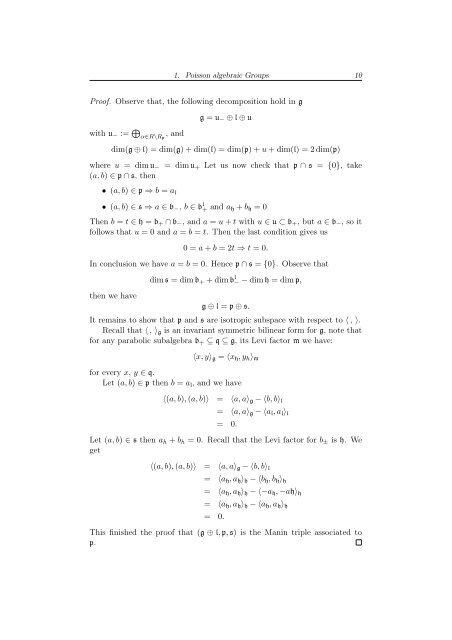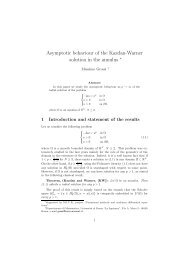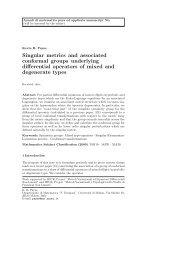Degree of Parabolic Quantum Groups - Dipartimento di Matematica ...
Degree of Parabolic Quantum Groups - Dipartimento di Matematica ...
Degree of Parabolic Quantum Groups - Dipartimento di Matematica ...
You also want an ePaper? Increase the reach of your titles
YUMPU automatically turns print PDFs into web optimized ePapers that Google loves.
1. Poisson algebraic <strong>Groups</strong> 10<br />
Pro<strong>of</strong>. Observe that, the following decomposition hold in g<br />
with u− := <br />
α∈R\Rp<br />
, and<br />
g = u− ⊕ l ⊕ u<br />
<strong>di</strong>m(g ⊕ l) = <strong>di</strong>m(g) + <strong>di</strong>m(l) = <strong>di</strong>m(p) + u + <strong>di</strong>m(l) = 2 <strong>di</strong>m(p)<br />
where u = <strong>di</strong>m u− = <strong>di</strong>mu+ Let us now check that p ∩ s = {0}, take<br />
(a, b) ∈ p ∩ s, then<br />
• (a, b) ∈ p ⇒ b = al<br />
• (a, b) ∈ s ⇒ a ∈ b−, b ∈ b l + and ah + bh = 0<br />
Then b = t ∈ h = b+ ∩ b−, and a = u + t with u ∈ u ⊂ b+, but a ∈ b−, so it<br />
follows that u = 0 and a = b = t. Then the last con<strong>di</strong>tion gives us<br />
0 = a + b = 2t ⇒ t = 0.<br />
In conclusion we have a = b = 0. Hence p ∩ s = {0}. Observe that<br />
then we have<br />
<strong>di</strong>ms = <strong>di</strong>mb+ + <strong>di</strong>mb l − − <strong>di</strong>mh = <strong>di</strong>mp,<br />
g ⊕ l = p ⊕ s.<br />
It remains to show that p and s are isotropic subspace with respect to 〈, 〉.<br />
Recall that 〈, 〉g is an invariant symmetric bilinear form for g, note that<br />
for any parabolic subalgebra b+ ⊆ q ⊆ g, its Levi factor m we have:<br />
〈x, y〉g = 〈xh, yh〉m<br />
for every x, y ∈ q.<br />
Let (a, b) ∈ p then b = al, and we have<br />
〈(a, b), (a, b)〉 = 〈a, a〉g − 〈b, b〉l<br />
= 〈a, a〉g − 〈al, al〉l<br />
= 0.<br />
Let (a, b) ∈ s then ah + bh = 0. Recall that the Levi factor for b± is h. We<br />
get<br />
〈(a, b), (a, b)〉 = 〈a, a〉g − 〈b, b〉l<br />
= 〈ah, ah〉h − 〈bh, bh〉h<br />
= 〈ah, ah〉h − 〈−ah, −ah〉h<br />
= 〈ah, ah〉h − 〈ah, ah〉h<br />
= 0.<br />
This finished the pro<strong>of</strong> that (g ⊕ l, p, s) is the Manin triple associated to<br />
p.








